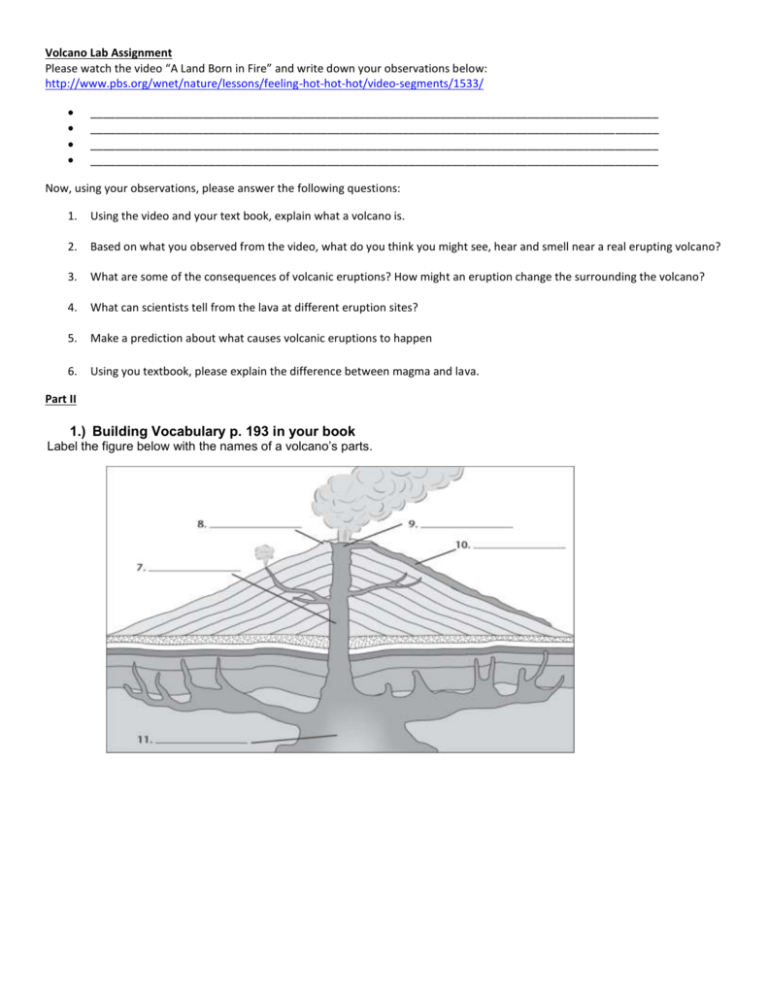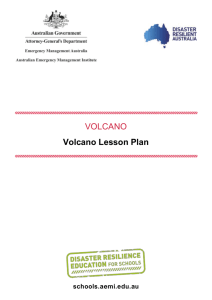Volcano Lab
advertisement

Volcano Lab Assignment Please watch the video “A Land Born in Fire” and write down your observations below: http://www.pbs.org/wnet/nature/lessons/feeling-hot-hot-hot/video-segments/1533/ ___________________________________________________________________________________________ ___________________________________________________________________________________________ ___________________________________________________________________________________________ ___________________________________________________________________________________________ Now, using your observations, please answer the following questions: 1. Using the video and your text book, explain what a volcano is. 2. Based on what you observed from the video, what do you think you might see, hear and smell near a real erupting volcano? 3. What are some of the consequences of volcanic eruptions? How might an eruption change the surrounding the volcano? 4. What can scientists tell from the lava at different eruption sites? 5. Make a prediction about what causes volcanic eruptions to happen 6. Using you textbook, please explain the difference between magma and lava. Part II 1.) Building Vocabulary p. 193 in your book Label the figure below with the names of a volcano’s parts. 2.) Now go to the following website and read about the three types of volcanoes and fill in the chart below, do not complete the build your own column at this time. At the site you will need to click volcano types (on the left hand side) http://kids.discovery.com/games/build-play/volcano-explorer Volcano Types Organizer Type Formation Shape Examples Levels Eruption Stratovolcano (quiet vs. explosive) Cinder Cone (quiet vs. explosive) Shield (quiet vs. explosive) (quiet vs. explosive) a. What factors might contribute to creating different types of volcanoes and eruptions? b. Now click on build your own volcano and watch it erupt. Try to build each type of volcano by adjusting the viscosity and gas settings. Record the setting and type of eruption that results on your chart. c. What two factors determine if an eruption is quiet or explosive? d. Describe a quiet eruption, what conditions (temp. and silica) are necessary, what types of lava are produced, where do they mostly occur? e. Describe an explosive eruption, what conditions (temp. and silica) are necessary, what causes it, where do they mostly occur, what is volcanic ash, what are bombs? ** There is also a 4th type of volcano that can be created, if you find it, you should fill in its information on the Volcano types organizer. Part III Go to the website below and watch the 2nd and 3rd video clips, “How to Build and Island from Scratch” and “Creating and Island Paradise”, then complete the questions below about the Hawaiian Islands http://www.pbs.org/wnet/nature/lessons/feeling-hot-hot-hot/video-segments/1533/ Hawaiian Islands 1. What is a hotspot? How does it form? Does it form at a plate boundary (this is also in text) ____________________________________________________________________________________________________________ ____________________________________________________________________________________________________________ 2. What is the name of the plate on which Hawaii sits? _______________________________________________________________ 3. In which direction does this plate move? _________________________________________________________________________ 4. What is the name of the new volcano? __________________________________________________________________________ 5. When will the new volcano break the surface of the ocean? ____________________________________________________________________________________________________________ 6. What will the volcano look like when it emerges? __________________________________________________________________ 7. What will the area surrounding the volcano look like in one hundred years? Why will it look that way? ____________________________________________________________________________________________________________ Part IV a.) Using a highlighter, highlight the ring of fire b.) What countries are involved in the ring of fire? c.) What plates are involved in the ring of fire? d.) At what type of boundary do most volcanoes occur? e.) Where can you find some volcanoes on the map that occur at other boundaries, what type of a boundary is this? f.) Using your textbook, tell me what an island arc is. Give me an example of an island arc. What specific type of convergent boundary forms these landforms? g.) What boundary leads to the formation Mount St. Helens and Mount Rainier? Now go to the following website and complete the case study for each volcano in the chart below http://www.learner.org/interactives/volcanoes/activty2/act2main.html Location Type Volcanic Zone Date & Type of Eruption (s) Case Study #1: Kilauea Case Study #2: Popocatépetl Case Study #3: Santorini Case Study #4: Surtsey Part V Go to the following site and choose screen size for medium. Once there click on “Ground Deformation” http://volcanoes.usgs.gov/about/edu/predict/index.php a. Write down three factors considered by the USGS scientists in predicting volcanic eruptions. b. Read and watch animations on the remaining pages of the Ground Deformation section and answer the following questions. Describe two changes that occurred on the surface of the dome as the magma moved upward? 1.________________________________________________________________ 2.________________________________________________________________ In the weeks and days before the eruptions, what happened to the distance between the metal stakes? __________________________________________________________________________________________________ How did the observations described in the previous question affect the scientists’ predictions? __________________________________________________________________________________________________ What happened to the crater floor just before eruption? __________________________________________________________________________________________________ Describe one method scientists use to analyze earthquake data. __________________________________________________________________________________________________ What happens to earthquakes before an eruption? __________________________________________________________________________________________________ Now click on “Exercise” on the left hand toolbar. Read and review the information presented on pages 1-3, and then use that information to make predictions and choose their actions on pages 4-6. Record your answers below A. B. C.








